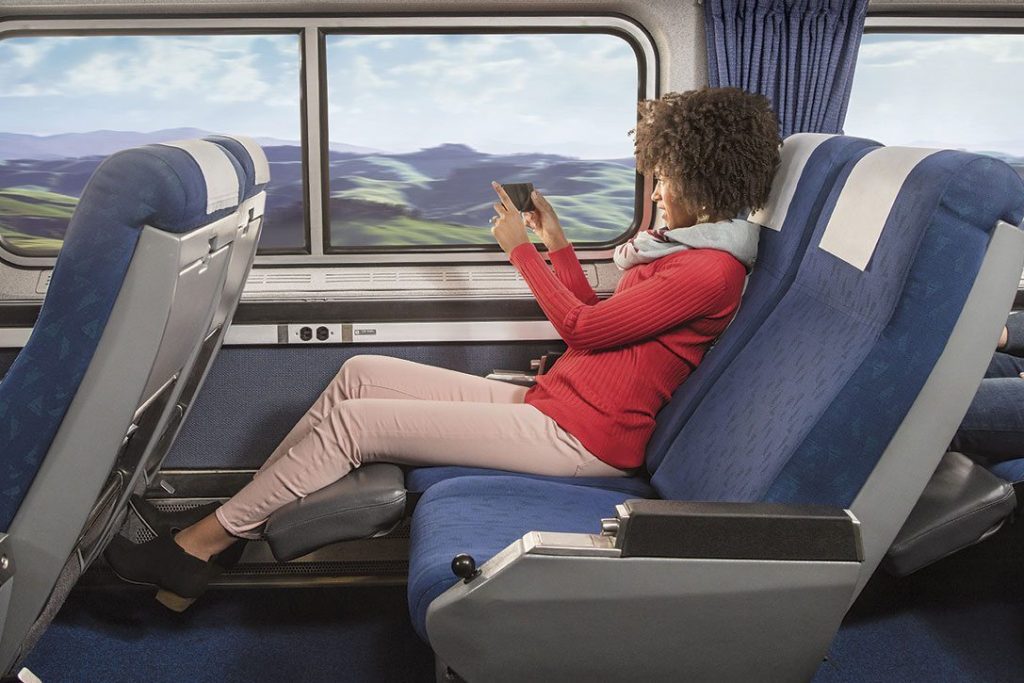Skift Take
Amtrak's new videos speak the truth about the easy comfort of train travel, while flying basic economy is rife with pain points. But how many flyers will become rail-converts for the comfort?
Amtrak has a new video ad campaign that takes airlines to task for making passengers uncomfortable. With basic economy — in which cheap airfares eliminate amenities — and having to slog through airport security, endure invasive pat-downs, and squeeze into a jam-packed plane, Amtrak positions itself as offering some relief to frustrated travelers.
“Too many people out there were accepting painful travel experiences,” said Kerry McKelvey, vice president of marketing at Amtrak.
In these videos, Amtrak promotes four free carry-on bags, power outlets and free Wi-Fi, no middle seats, more legroom, the freedom to move about the train and enjoy the observatory car with floor-to-ceiling windows, and generally a more humane experience.
“Traveling shouldn’t feel like work, especially when it’s for fun,” says the campaign’s website.
Basic Economy for Amtrak
To the contrary, outgoing Amtrak CEO Wick Moorman discussed the possibility of introducing basic economy with reduced legroom to increase revenue, as the company struggles with funding and mounting maintenance costs.
Amtrak’s incoming CEO, Richard Anderson — formerly the CEO of Delta Air Lines — has some people worried that Amtrak will mimic the airlines and move forward with restrictive basic economy service. Moorman and Anderson are currently serving as co-CEOs with Anderson fully taking the helm in January 2018.
When asked about the possibility of basic economy, McKelvey said that the current spacious legroom and comfortable seating “will absolutely continue to be part of the Amtrak experience.”
However, barring any future introduction of basic economy: Is taking Amtrak, which is frequently more expensive than flying, a workable solution for most people?
That depends on the target market.
McKelvey said that for this campaign, called “Break the Travel Quo,” a significant part of the target market is comprised of new Amtrak customers, for example, people who consistently drive or fly, rather than commuters who already use Amtrak regularly.
“We’re zeroing in on the headaches that people have with car travel, all the traffic, the tolls, the inability for people in the car to really socialize and have family time.”
Amtrak is most heavily used in the congested Northeast Corridor of the U.S., in which commuters and business travelers shuttling between Boston, New York, Philadelphia, Washington D.C., and other hubs rely on trains because of their speed. Cars and popular discount buses like Megabus and BoltBus can get stuck in horrendous traffic.
A startup called Cabin is trying to disrupt that cheap bus market in California by offering sleep pods to make overnight bus rides doable, maybe even pleasurable. Yet much like Amtrak, the price barely undercuts that of flying, if at all.
When it comes to leisure travel, Amtrak has long had difficulty capturing that market because for many of those longer vacations to further-away places, an airplane is much quicker and more affordable. The popularity of basic economy shows that many travelers would rather grit their teeth through the discomfort than pay more.
“We think there’s a lot of longevity in this campaign,” said McKelvey, implying that the pain points of traveling by air aren’t disappearing anytime soon.
The Daily Newsletter
Our daily coverage of the global travel industry. Written by editors and analysts from across Skift’s brands.
Have a confidential tip for Skift? Get in touch
Tags: amtrak, basic economy, rail
Photo credit: Amtrak is trying to capture new customers who are sick of flying uncomfortably Amtrak's latest ad campaign is pictured here. Amtrak
